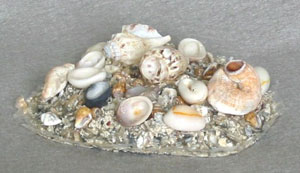Greener Earth
Hello,
Our Kids Science Newsletter this month includes a kids science activity with seashells, news about a greener Earth, fun trivia about sailors and cloud formations plus information on how apes learn sign language.
Question of the Month
How do apes learn sign language?
(answer follows the simple science experiment)
Science Current Events
- Greener Earth
- Often we hear about deforestation in some areas on our planet that are the result of cutting down rainforests. A new study has found that the Earth is becoming greener due to massive tree-planting projects in China. Also vegetation has increased in the savannahs of Australia, Africa and South America due to increasing rainfall. Russia and some of the former Soviet republics has increased its vegetation primarily in abandoned farmland. China is the only country worldwide that has intentionally increased its vegetation by planting trees. The greatest lost of vegetation on Earth were the edges of the Amazon forests, Sumatra and portions of Borneo.
- Pacific Northwest Coastal Waters
- A warm blob of unusually warm water is located off the coast of the Pacific Northwest. Scientists are studying the warm waters that began to be observed in the fall of 2013 and early 2014. It is a large circular mass of warm water that may be
causing the severe winter's snowstorms in the eastern half of North America and the Arctic areas. Scientists are keeping watch on the area to see if the warm waters linger for a third straight year.
- Dolphin Deaths Bring Tsunami Fears in Japan
- Six days prior to the 2011 earthquake and tsunami that struck Japan a group of dolphins were stranded on the coast of Japan. Scientists thought the previous stranding might have been linked to movement on the seafloor off the coast of Japan. More than 100 melon-headed whales washed up on the shores northeast of Tokyo recently. Scientists believe that a parasitic infection was the cause of these deaths. Melon-headed whales are a type of dolphin that are rarely seen because they prefer deep water.
Science Trivia
- The biggest gingerbread house was decorated with 4,750 pounds of icing.
- The Alps is the highest mountain range in western Europe. The mountains run through southeastern France, Switzerland, Italy and Austria. The highest peak is Mont Blanc, at 15781 feet (4810 meter).
- For centuries sailors lost at sea have used clouds to guide them to land. Fleecy clouds on the horizon often form above islands.
- Raindrops are rarely more than 0.2 inch (5 mm) in diameter because larger ones break up into smaller drops. Raindrops are large in heavy rain. Drops less than 0.02 inch (0.5 mm) are called drizzle.
Simple Science Activity
Cookie Dig
Introduction
Sea creatures extract calcite from ocean water to form homes that protect them from predators. When they die the seashells that were their home and protection fall to the ocean floor. In this activity you will be creating a limestone rock similar to coquina limestone rocks made of broken bits and pieces of shells.

Materials
- Broken pieces of shells (seashells, eggshells, etc.)
- White glue (School glue, Elmers glue, etc.)
- Paper cup
- Plastic spoon
- Plastic wrap
Directions
- Stir broken shells in a paper cup until they are thoroughly mixes.
- Mix 1 part white glue to 2 parts water in a paper c up.
- Pour the watered down glue over the shells.
- Stir the shells and flue until the shells are thoroughly moistened.
- Pour the mixture onto a piece of plastic wrap.
- Place a few of the larger pieces of broken shells on the top and glue them into place.
- After the limestone is dry, feel the surface to determine it is smooth or rough.
- Try breaking some eggshells into a very fine powder. Using white glue create another limestone rock.
Science behind the formation of coquina, a limestone rock
Seashells rolling around on the ocean floor become broken and
compact into sedimentary layers. The seashells when exposed to air form coquina, a limestone rock that is partly cemented shells and shell fragments of recent origin. Citizens of Saint Augustine, Florida used coquina to build a fort and gates to their city. The town was founded in 1565 and the fort and city gates are still standing.
Answer to the question of the month
How do apes learn sign language?
Apes learn sign language based on the hand signals that deaf people use. The apes watch their trainers hands and imitate the movements. When they get it right they are rewarded with food. Koko, a gorilla who died in 2000, knew over 1,000 signs.
Links to our back issues of Kids Science Newsletter
Our Other Websites
Ring of Fire Science
The-Science-Site
Kids-Earth-Science
Please share this newsletter with a friend by forwarding it to them. If you know of a group who might enjoy the newsletter please let them know about it also.
Comments? Ideas? Feedback? I'd love to hear from you. Just reply to this Just For Kids Science Newsletter and tell me what you think!
Have a nice day,
Myrna Martin

